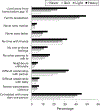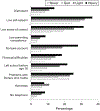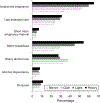The psychosocial context of pregnancy smoking and quitting in the Millennium Cohort Study
- PMID: 19258350
- PMCID: PMC10263303
- DOI: 10.1136/jech.2008.082594
The psychosocial context of pregnancy smoking and quitting in the Millennium Cohort Study
Abstract
Background: Although pregnancy is a time when women have increased motivation to quit smoking, approximately half of female smokers persist in smoking throughout their pregnancies. Persistent pregnancy smokers are known to be more nicotine dependent and to have greater sociodemographic disadvantage. Less is known about the psychosocial context of persistent pregnancy smokers and factors that distinguish them from pregnancy quitters.
Methods: A cross-sectional study was conducted within the UK Millennium Cohort Study. Participants were 18 225 women, including 13.3% quitters, 12% light smokers and 8% heavy smokers. Data were collected when the infants were 9 months old. Maternal psychosocial problems were assessed in three domains: interpersonal, adaptive functioning and health-related behaviours.
Results: In general, psychosocial problems in all domains increased across the pregnancy smoking continuum (non-smoker, quitter, light smoker, heavy smoker). All three psychosocial domains added incremental utility to prediction of pregnancy smoking status, after adjustment for sociodemographic risk.
Conclusion: Problems in multiple psychosocial domains systematically distinguish women along a pregnancy smoking gradient, with heavy smokers having the most problematic psychosocial context. This subgroup of pregnant smokers is unlikely to be able to benefit from usual-care antenatal cessation interventions, which rely on women's capacity for self-initiation, self-control and social resources. Consideration should be given to tiered interventions that provide more intensive and targeted interventions to pregnant women unable to quit with usual care.
Conflict of interest statement
Figures



References
-
- Institute of Medicine. Health and behavior: the interplay of biological, behavioral, and societal influences. Washington, District of Columbia: National Academy Press, 2001. - PubMed
-
- Bouton ME. A learning theory perspective on lapse, relapse, and the maintenance of behavior change. Health Psychol 2000;19(Suppl 1):57–63. - PubMed
-
- Glasgow RE, Bull SS, Gillette C, et al. Behavior change intervention research in healthcare settings: a review of recent reports with emphasis on external validity. Am J Prev Med 2002;23:62–9. - PubMed
-
- Oldenburg BF, Sallis JF, Ffrench ML, et al. Health promotion research and the diffusion and institutionalization of interventions. Health Educ Res 1999;14:121–30. - PubMed
-
- Jeffery RW, Drewnowski A, Epstein LH, et al. Long-term maintenance of weight loss: current status. Health Psychol 2000;19(Suppl 1):5–16. - PubMed
Publication types
MeSH terms
Grants and funding
LinkOut - more resources
Full Text Sources
Medical
